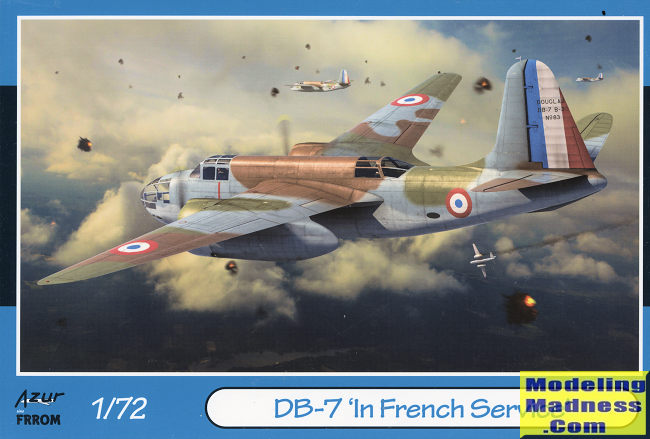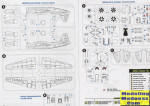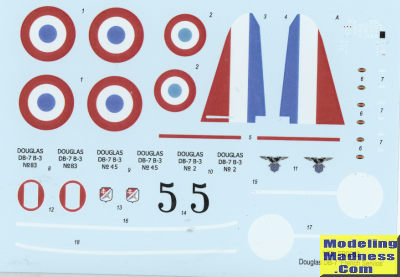
Azur/FRROM 1/72 Douglas DB-7 'French Service'
| KIT #: | FR 0052 |
| PRICE: | |
| DECALS: | Three options |
| REVIEWER: | Scott Van Aken |
| NOTES: | 2024 release |

| HISTORY |
In 1937, the United States Army Air Corps (USAAC) issued a new specification for an attack aircraft. To meet this requirement, the Douglas team, now headed by Heinemann, developed the Model 7B, with a similar layout to the 7A, but was powered by 1,100 hp (820 kW) Pratt & Whitney R-1830-S3C3-G Twin Wasp 14-cylinder engines, and carried a bombload of up to 2,000 lb (910 kg). It faced competition from the North American NA-40, Stearman X-100, Martin 167F, and an unbuilt design from Bell Aircraft, the Model 9. The Air Corps invited all five companies to build prototypes at their own expense and to submit sealed bids for production of their aircraft.
The prototype Model 7B made its first flight on 26 October 1938. The model attracted the attention of a French Purchasing Commission visiting the United States. The French discreetly participated in the flight trials, so as not to attract criticism from American isolationists. The Model 7B crashed on 23 January 1939 while demonstrating single-engine performance, killing the test pilot and seriously injuring a French observer aboard the aircraft. The presence of a foreigner on a test flight for an aircraft still under development caused a scandal in the press. Despite the crash, the French were impressed enough to place an order for 100 production aircraft on 15 February 1939, following this up with an order for 170 more in October 1939.
DB-7s began to be delivered from Douglas's El Segundo, California production line on 31 October 1939, and the passing of the "Cash and Carry" act on 4 November 1939 allowed the aircraft to be handed over in the United States to the French, who would then be responsible for delivering the aircraft. The DB-7s were shipped to Casablanca in French North Africa where they were reassembled and tested before being handed over to operational units of the Armée de l'Air. When the Germans attacked France and the Low Countries on 10 May 1940, about 70 DB-7s had reached North Africa, equipping three Escadrilles (squadrons), which were transferred from Africa to the French mainland in response to the German attack. They flew about 70 sorties against the advancing Germans during the Battle of France, with at least eight aircraft being lost, but before the armistice surviving aircraft were evacuated to North Africa to avoid capture. Here, they came under the control of the Vichy government and briefly engaged the Allies during Operation Torch, the Allied invasion of French North Africa in November 1942.
| THE KIT |
 MPM/Special
Hobby have already released just about all variants of the A-20 over the past
few years. What has not been released is the earlier French DB-7. These aircraft
were different in a few major ways, including a different fin/rudder and engines
to the later offerings. These differences would require some additional tooling
to portray these features accurately. Now, with the release of this kit from
Azur/FRROM, we can now model an accurate French DB-7 in 1/72 scale.
MPM/Special
Hobby have already released just about all variants of the A-20 over the past
few years. What has not been released is the earlier French DB-7. These aircraft
were different in a few major ways, including a different fin/rudder and engines
to the later offerings. These differences would require some additional tooling
to portray these features accurately. Now, with the release of this kit from
Azur/FRROM, we can now model an accurate French DB-7 in 1/72 scale.
It should come as no surprise that some of the sprues of this kit are identical from the other releases, so those who have built the later variations will find quite a bit to be familiar. The kit provides a nicely detailed cockpit and rear gunner's area with these areas being the first to be built. This is followed by the main landing gear wells. There are inserts for the cockpit side panels and a note cautioning the builder to test fit those before applying cement. Note that the instructions call for all the gear wells and interior to be basically US interior green. While this works for most, others may wish to paint the gear wells with chromate green, which can be a slightly different shade.
Instructions mention the need for 10 grams of nose
weight, but, a wise modeler will want to pack as much as possible in the space
under the cockpit and behind it. With the halves closed, the wings are glued
together along with the tailplanes. Those a re
then attached. The next steps involve building up the engines along with the
nose and main landing gear. Since each main gear is seven pieces, these may
prove to be the most fiddly part of the build. Once those are attached to the
lower wing, the rest of the nacelles can be added along with the engines and
cowlings. Gear doors are next. The final bits are the clear pieces, props and
weapons.
re
then attached. The next steps involve building up the engines along with the
nose and main landing gear. Since each main gear is seven pieces, these may
prove to be the most fiddly part of the build. Once those are attached to the
lower wing, the rest of the nacelles can be added along with the engines and
cowlings. Gear doors are next. The final bits are the clear pieces, props and
weapons.
Instructions are well done with Gunze color information provided. All three markings options are in green khaki, dark brown, dark grey-blue over light blue-grey. The box art plane is from GB II/32 operating in France during June 1940. The other two are in early Vichy markings with GB I/32 and II/32 in North Africa during 1941. The decals are nicely done and in perfect register.
| CONCLUSIONS |
This is a very nice kit and it is great to finally have a proper early French DB.7. I'm betting there is a mask set for this and it is something you'll find quite useful for doing the canopy and nose section.
| REFERENCES |
https://en.wikipedia.org/wiki/Douglas_A-20_Havoc#Variants
August 2024
My thanks to Azur/FRROM for the review sample.
Copyright ModelingMadness.com. All rights reserved. No
reproduction in part or in whole without express permission of the editor.
If you would like your product reviewed fairly and fairly quickly, please contact the editor or see other details in the
Note to
Contributors. Back to the Main Page
Back to the Review
Index Page
Back to the Previews Index Page